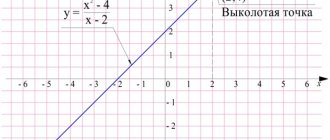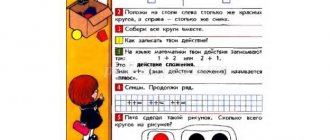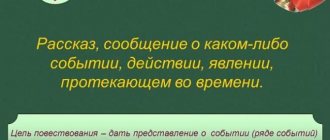Outline of a mathematics lesson on the topic “Scale”
Math lesson plan for 6th grade.
Author Mitrofanova L.A., teacher at St. Petersburg State Budgetary Educational Institution
"St. Petersburg Musical Lyceum".
Lesson topic
:
"Scale".
Lesson type: integrated lesson to consolidate knowledge.
Goals and objectives of the lesson
(in accordance with the requirements of the Federal State Educational Standard).
Goals:
Subject: strengthening the ability to work with scale; mastery of mathematical knowledge and skills necessary to continue studying mathematics in primary and secondary schools; creating the foundation for mathematical development, the formation of thinking mechanisms characteristic of mathematical activity.
Personal: developing the ability to present the result of one’s activities; nurturing personality traits that ensure speech culture, social mobility, and curiosity; development of critical thinking ability.
Meta-subject: developing the ability to define concepts, create generalizations, establish analogies; the formation of general methods of intellectual activity, characteristic of mathematics and which are the basis of cognitive culture, significant for various spheres of human activity; development of skills in educational and cognitive activities.
Tasks:
Subject: systematize and generalize students’ knowledge on the topic: “Relationships. Scale"; check the level of knowledge on this topic through various forms of work: the ability to construct a speech statement, analyze the condition of the problem and the ability to present it in mathematical language, the ability to use existing knowledge obtained in other subject areas in the proposed circumstances.
Personal: to cultivate students’ interest in mathematics; contribute to the formation of students’ communicative competence, the ability to organize educational cooperation and joint activities with the teacher and peers; develop the ability to analyze and draw conclusions.
Meta-subject: to form students’ ideas about the subject of mathematics as a science, which is an integral part of any sphere of human activity.
Planned learning outcomes
:
Subject: the student will understand the connection between mathematics and geography; learn to work with text (analyze, extract the necessary information, build a mathematical model, build an algorithm for solving a problem), accurately and competently express your thoughts using mathematical terminology; will learn to apply the basic property of ratio, apply the concept of scale when solving problems.
Personal: the student will learn to clearly, accurately, competently and reasonably express his thoughts in oral and written speech, understand the meaning of the task; plan educational collaboration with teachers and peers; control the process and result of your educational activities.
Meta-subject: the student will learn to plan his cognitive activity; define concepts, competently express your point of view, offer various ways to solve the proposed tasks, find the optimal way to solve them; distinguish the new from the already known; find answers to questions using your life experience and knowledge gained in geography lessons.
Lesson progress with description of tasks
Handouts: copies of the page of the Small ATLAS of the WORLD - Russia, sheets with a map of the Smolninskoe municipal district of the Central region of St. Petersburg; student self-assessment sheets.
Technical equipment: laptop, interactive whiteboard.
Brief description of the main stages of the lesson.
1
. Organizational stage. Setting formulated results and objectives of the lesson. Motivation for students' learning activities.
Students are asked to complete a task so that they can independently formulate the topic of the lesson. A task appears on the interactive board:
- Find a relationship. Write in the table the letters corresponding to the answers found.
| 26 | 6 | 26 | 0,9 |
- A
- 1.04 : 0.04;
4) b -
14.4 dm: 160 cm; - T -
1.3: 3.9;
5) w -
26 m: 2.6 km; - With
- 3 dm: 5 cm;
6) m -
8 m: 1 km.
Answer:
| 26 | 6 | 26 | 0,9 | |||
| m | A | With | w | T | A | b |
The resulting word is scale. Students formulate the topic of the lesson. (Scale)
2
. Updating knowledge.
Let us repeat what a map scale is (the ratio of the length of a segment on the map to the length of the corresponding segment on the ground). What does the scale show? (the scale shows how many times the distance on the map is less than the distance on the ground)
Take sheets with a map of Russia. Using a scale, we will find the distance from St. Petersburg to Veliky Novgorod.
Map scale 1: 5000000. What does this mean? (50 km in 1 cm) Measure on the map using a ruler the distance from St. Petersburg to Veliky Novgorod (3.3 cm). Calculate what distance is obtained on the ground (3.3 * 50 = 165 km)
Now let’s find out what time you need to leave St. Petersburg in order to catch the excursion in V. Novgorod, which starts at 11:30 a.m., if the average bus speed is 60 km/h (165: 60 = 2 hours = 2 hours 45 minutes) Correct , which means you need to leave no later than 8 hours 15 minutes, so that there is still a small amount of time left.
Handout.
World Atlas – Russia.
3
. Consolidation of the studied material.
Now we will work in pairs. You have two more sheets on your desks: on one of them the route from the Chernyshevskaya metro station to our lyceum is laid out, and on the second - from the Ploshchad Vosstaniya metro station to the lyceum. Find out which station is the fastest to get to the Lyceum and by how much. The scale of the first map is 1: 7700, the second is 1: 15000; On average, a person walks 4 km per hour. Agree who works on the first route and who on the second. And then exchange the results and answer the question.
( 1) 1.4 + 2.8 + 2.1 + 3.1 + 2.3 + 1.2 + 1 + 2.6 + 1.2 + 8 + 1 = 26.7 cm – length of the first route on map; 26.7 * 7700 = 205590 cm approximately 2 km on the ground.
2) 0.7 + 1.4 + 1.5 + 1.6 + 2.3 + 2.6 + 2.6 + 1.5 + 0.8 + 1.8 + 0.2 + 3.2 = 20.2 cm – the length of the second route on the map; 20.2 * 15000 = 303000 cm approximately 3 km on the ground.
3) 2: 4 = h = 30 min.
4) 3: 4 = h = 45 min. )
Thus, the route from the Chernyshevskaya metro station takes 15 minutes less.
Handout.
Metro station "Chernyshevskaya" - Musical Lyceum.
Metro station "Ploshchad Vosstaniya" - Musical Lyceum.
4
. Setting homework.
Draw a plan of your room on a scale of 1:50.
5
. Reflection on learning activities in the classroom.
Evaluate the activity of your work in class. Take the self-assessment sheets and circle the answer that matches your work in class.
During the lesson I: a) worked actively; b) worked, but not actively; c) was (a) passive.
Analysis of the given lesson
The topic of the lesson corresponds to the program of basic general education within the framework of the implementation of the Federal State Educational Standard in mathematics. The content of the lesson meets the requirements of the program and the age characteristics of the students; aimed at the formation of personal, meta-subject, subject results and universal educational actions.
During the lesson, the emphasis was placed on the significance and value of the material being studied, which helped create an emotional mood for work and provide students with the necessary motivation. In a relaxed manner, students learned to use their existing knowledge to answer the question posed to them; thinking, memory, and imagination were activated, and the desire to learn more was stimulated.
Learning activities in the lesson were formed by frontal, individual forms of work and work in pairs. At the stage of consolidating knowledge, skills and abilities, work was organized aimed at developing computing skills.
Upon completion of the reflection stage, it can be stated that the objectives of the lesson were achieved, all students completed the lesson on a positive emotional level.






